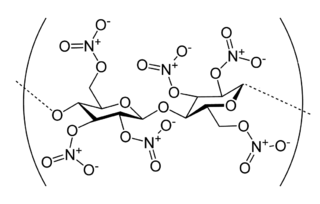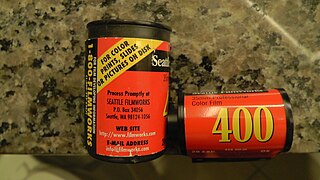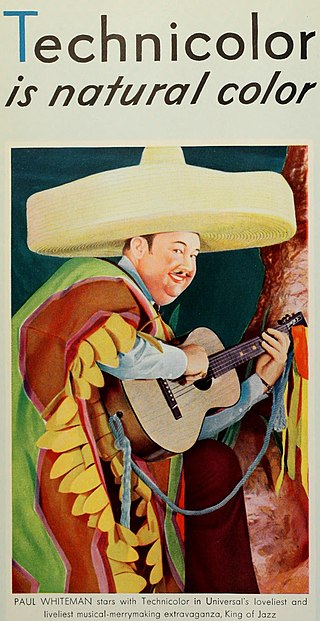Related Research Articles

Film stock is an analog medium that is used for recording motion pictures or animation. It is recorded on by a movie camera, developed, edited, and projected onto a screen using a movie projector. It is a strip or sheet of transparent plastic film base coated on one side with a gelatin emulsion containing microscopically small light-sensitive silver halide crystals. The sizes and other characteristics of the crystals determine the sensitivity, contrast and resolution of the film. The emulsion will gradually darken if left exposed to light, but the process is too slow and incomplete to be of any practical use. Instead, a very short exposure to the image formed by a camera lens is used to produce only a very slight chemical change, proportional to the amount of light absorbed by each crystal. This creates an invisible latent image in the emulsion, which can be chemically developed into a visible photograph. In addition to visible light, all films are sensitive to X-rays and high-energy particles. Most are at least slightly sensitive to invisible ultraviolet (UV) light. Some special-purpose films are sensitive into the infrared (IR) region of the spectrum.

Keykode is an Eastman Kodak Company advancement on edge numbers, which are letters, numbers and symbols placed at regular intervals along the edge of 35 mm and 16 mm film to allow for frame-by-frame specific identification. It was introduced in 1990.

35 mm film is a film gauge used in filmmaking, and the film standard. In motion pictures that record on film, 35 mm is the most commonly used gauge. The name of the gauge is not a direct measurement, and refers to the nominal width of the 35 mm format photographic film, which consists of strips 1.377 ± 0.001 inches (34.976 ± 0.025 mm) wide. The standard image exposure length on 35 mm for movies is four perforations per frame along both edges, which results in 16 frames per foot of film.

Nitrocellulose is a highly flammable compound formed by nitrating cellulose through exposure to a mixture of nitric acid and sulfuric acid. One of its first major uses was as guncotton, a replacement for gunpowder as propellant in firearms. It was also used to replace gunpowder as a low-order explosive in mining and other applications. In the form of collodion it was also a critical component in an early photographic emulsion, the use of which revolutionized photography in the 1860s.

ORWO is a registered trademark of the company ORWO Net GmbH, based in Wolfen and is also traditionally known for black-and-white film products, made in Germany and sold under the ORWO brand.

Kodachrome is the brand name for a color reversal film introduced by Eastman Kodak in 1935. It was one of the first successful color materials and was used for both cinematography and still photography. For many years, Kodachrome was widely used for professional color photography, especially for images intended for publication in print media.
Leopold Godowsky Jr., the oldest son of the famous pianist and composer Leopold Godowsky, was an American violinist and chemist, who together with Leopold Mannes created the first practical color transparency film, Kodachrome.
A film base is a transparent substrate which acts as a support medium for the photosensitive emulsion that lies atop it. Despite the numerous layers and coatings associated with the emulsion layer, the base generally accounts for the vast majority of the thickness of any given film stock. Since the late 19th century, there have been three major types of film base in use: nitrate, acetate, and polyester.

Color motion picture film refers both to unexposed color photographic film in a format suitable for use in a motion picture camera, and to finished motion picture film, ready for use in a projector, which bears images in color.
Trucolor was a color motion picture process used and owned by the Consolidated Film Industries division of Republic Pictures. It was introduced as a replacement for Consolidated's own Magnacolor process.
Separation masters are a method of long-term preservation for most modern color motion picture film. Since monopack color film - used in such processes as ECN, ECP and their successive revisions - contains photographically active color couplers which remain in the film after development, the emulsion will continue to produce chemical reactions in the image which cumulatively create a color fading, usually heavily biased towards the pink spectrum. In order to protect against this occurrence, the technique of separation masters was created.
Pathécolor, later renamed Pathéchrome, was an early mechanical stencil-based film tinting process for movies developed by Segundo de Chomón for Pathé in the early 20th century. Among the last feature films to use this process were the British revue film Elstree Calling (1930) and the Mexican film Robinson Crusoe (1954) by Spanish Surrealist Luis Buñuel.
In bipack color photography for motion pictures, two strips of black-and-white 35 mm film, running through the camera emulsion to emulsion, are used to record two regions of the color spectrum, for the purpose of ultimately printing the images, in complementary colors, superimposed on one strip of film. The result is a multicolored projection print that reproduces a useful but limited range of color by the subtractive color method. Bipack processes became commercially practical in the early 1910s when Kodak introduced duplitized film print stock, which facilitated making two-color prints.
DeLuxe Color or Deluxe color or Color by DeLuxe is Deluxe Laboratories' brand of color process for motion pictures. DeLuxe Color is Eastmancolor-based, with certain adaptations for improved compositing for printing and for mass-production of prints. Eastmancolor, first introduced in 1950, was one of the first widely-successful "single strip color" processes, and eventually displaced three-strip Technicolor.

Seattle FilmWorks, Inc., was a mail order photographic film processing company that sold re-spooled 35mm motion picture film. It was founded in 1976 as American Passage Marketing by Gilbert Scherer. At its peak in 1997, Seattle FilmWorks employed approximately 800 people and processed about 20 miles of film a day in a 65,000 sq ft lab. In 1978, Seattle FilmWorks started selling motion picture film that is processed using Kodak's ECN-2 process. The film was loaded into 35mm film canisters for still photography use, and the company returned an unexposed roll with each order. In the 1980s, Seattle FilmWorks aggressively marketed its products and services and offered two rolls of Seattle FilmWorks film for US$2.00. It advertised in newspapers, magazines, and package inserts. Seattle FilmWorks was sold and renamed PhotoWorks in 1999. Its marketing practices led to a lawsuit against the company in 2000, which was settled a year later, and the company was later closed.

Technicolor is a series of color motion picture processes, the first version dating back to 1916, and followed by improved versions over several decades.

Cinestill Film is a Los Angeles-based company selling photographic film for analog cameras in collaboration with Kodak motion picture cinema film stock. The two brothers who founded the company started as a small business shooting wedding photography, hacking cameras and lenses, then moved on to chemically adapting cinema film so it could be processed at photo labs.
The South Indian film industry produced colour films since the 40s, especially the Kollywood. The earliest colour films in India were also produced in South India.
References
- ↑ Merritt, russell (2008). "Crying In Color: How Hollywood Coped When Technicolor Died" (PDF). NFSA Journal. 3. Nfsa.gov. Archived from the original (PDF) on 2016-03-03. Retrieved 2015-05-06.
- ↑ Peter Lev. Transforming the Screen, 1950-1959. University of California Press, 2003. p. 108.
- ↑ Stephen Neale. Contemporary Hollywood Cinema. Psychology Press, 1998. p. 120.
- ↑ "Oklahoma 1955 film". Alamy. Retrieved 21 September 2020.
- ↑ "The Bolshoi Ballet (1957, UK) cert. U". The David Lean Cinema. Retrieved 2020-02-02.
- ↑ MacGillivray, Greg; Freeman, Jim (1976-07-04). "Producing the IMAX Motion Picture: 'To Fly'". American Cinematographer . Vol. 57, no. 7. Hollywood: American Society of Cinematographers. pp. 750–809. ISSN 0002-7928. ProQuest 196332360.